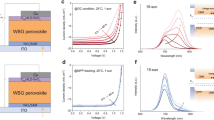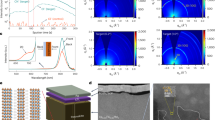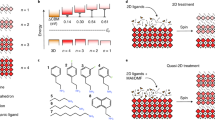Abstract
Defects at the top and bottom interfaces of three-dimensional (3D) perovskite photoabsorbers diminish the performance and operational stability of perovskite solar cells owing to charge recombination, ion migration and electric-field inhomogeneities1,2,3,4,5. Here we demonstrate that long alkyl amine ligands can generate near-phase-pure 2D perovskites at the top and bottom 3D perovskite interfaces and effectively resolve these issues. At the rear-contact side, we find that the alkyl amine ligand strengthens the interactions with the substrate through acid–base reactions with the phosphonic acid group from the organic hole-transporting self-assembled monolayer molecule, thus regulating the 2D perovskite formation. With this, inverted perovskite solar cells with double-side 2D/3D heterojunctions achieved a power conversion efficiency of 25.6% (certified 25.0%), retaining 95% of their initial power conversion efficiency after 1,000 h of 1-sun illumination at 85 °C in air.
This is a preview of subscription content, access via your institution
Access options
Access Nature and 54 other Nature Portfolio journals
Get Nature+, our best-value online-access subscription
$29.99 / 30 days
cancel any time
Subscribe to this journal
Receive 51 print issues and online access
$199.00 per year
only $3.90 per issue
Buy this article
- Purchase on Springer Link
- Instant access to full article PDF
Prices may be subject to local taxes which are calculated during checkout



Similar content being viewed by others
Data availability
The datasets generated during and/or analysed during the current study are available from the corresponding author upon request.
References
Ni, Z. et al. Evolution of defects during the degradation of metal halide perovskite solar cells under reverse bias and illumination. Nat. Energy 7, 65–73 (2022).
Ni, Z. et al. Resolving spatial and energetic distributions of trap states in metal halide perovskite solar cells. Science 367, 1352–1358 (2020).
Chen, H. et al. Regulating surface potential maximizes voltage in all-perovskite tandems. Nature 613, 676–681 (2023).
Jiang, Q. et al. Surface reaction for efficient and stable inverted perovskite solar cells. Nature 611, 278–283 (2022).
Tan, S. et al. Stability-limiting heterointerfaces of perovskite photovoltaics. Nature 605, 268–273 (2022).
Jung, E. H. et al. Efficient, stable and scalable perovskite solar cells using poly(3-hexylthiophene). Nature 567, 511–515 (2019).
Yang, G. et al. Stable and low-photovoltage-loss perovskite solar cells by multifunctional passivation. Nat. Photon. 15, 681–689 (2021).
Chen, H. et al. Quantum-size-tuned heterostructures enable efficient and stable inverted perovskite solar cells. Nat. Photon. 16, 352–358 (2022).
Luo, L. et al. Stabilization of 3D/2D perovskite heterostructures via inhibition of ion diffusion by cross-linked polymers for solar cells with improved performance. Nat. Energy 8, 294–303 (2023).
Jang, Y.-W. et al. Intact 2D/3D halide junction perovskite solar cells via solid-phase in-plane growth. Nat. Energy 6, 63–71 (2021).
Sidhik, S. et al. Deterministic fabrication of 3D/2D perovskite bilayer stacks for durable and efficient solar cells. Science 377, 1425–1430 (2022).
Azmi, R. et al. Damp heat-stable perovskite solar cells with tailored-dimensionality 2D/3D heterojunctions. Science 376, 73–77 (2022).
Niu, T. et al. Spacer engineering of diammonium-based 2D perovskites toward efficient and stable 2D/3D heterostructure perovskite solar cells. Adv. Energy Mater. 12, 2102973 (2022).
Proppe, A. H. et al. Multication perovskite 2D/3D interfaces form via progressive dimensional reduction. Nat. Commun. 12, 3472 (2021).
Azmi, R. et al. Moisture-resilient perovskite solar cells for enhanced stability. Adv. Mater. https://doi.org/10.1002/adma.202211317 (2023).
Gu, H. et al. Phase-pure two-dimensional layered perovskite thin films. Nat. Rev. Mater. 8, 533–551 (2023).
Yang, X. et al. Buried interfaces in halide perovskite photovoltaics. Adv. Mater. 33, 2006435 (2021).
Mahmud, M. A. et al. Cation-diffusion-based simultaneous bulk and surface passivations for high bandgap inverted perovskite solar cell producing record fill factor and efficiency. Adv. Energy Mater. 12, 2201672 (2022).
Mahmud, M. A. et al. Double-sided surface passivation of 3D perovskite film for high-efficiency mixed-dimensional perovskite solar cells. Adv. Funct. Mater. 30, 1907962 (2020).
Wu, S. et al. Modulation of defects and interfaces through alkylammonium interlayer for efficient inverted perovskite solar cells. Joule 4, 1248–1262 (2020).
Degani, M. et al. 23.7% efficient inverted perovskite solar cells by dual interfacial modification. Sci. Adv. 7, eabj7930 (2021).
Kyuji, O. Prediction of pKa values of alkylphosphonic acids. Bull. Chem. Soc. Jpn 65, 2543–2545 (1992).
Dorner, R. W., Deifallah, M., Coombes, D. S., Catlow, C. R. A. & Corà, F. Synthesis and structure determination of a novel layered aluminophosphate material templated with 1-phenylethylamine: [AlPO4(OH)](NH3C2H4C6H5). Chem. Mater. 19, 2261–2268 (2007).
Szatyłowicz, H. Structural aspects of the intermolecular hydrogen bond strength: H-bonded complexes of aniline, phenol and pyridine derivatives. J. Phys. Org. Chem. 21, 897–914 (2008).
Chen, S. et al. Stabilizing perovskite-substrate interfaces for high-performance perovskite modules. Science 373, 902–907 (2021).
Li, H. et al. 2D/3D heterojunction engineering at the buried interface towards high-performance inverted methylammonium-free perovskite solar cells. Nat. Energy 8, 946–955 (2023).
Stolterfoht, M. et al. The impact of energy alignment and interfacial recombination on the internal and external open-circuit voltage of perovskite solar cells. Energy Environ. Sci. 12, 2778–2788 (2019).
Alanazi, A. Q. et al. Benzylammonium-mediated formamidinium lead iodide perovskite phase stabilization for photovoltaics. Adv. Funct. Mater. 31, 2101163 (2021).
Cao, D. H., Stoumpos, C. C., Farha, O. K., Hupp, J. T. & Kanatzidis, M. G. 2D homologous perovskites as light-absorbing materials for solar cell applications. J. Am. Chem. Soc. 137, 7843–7850 (2015).
Quintero-Bermudez, R. et al. Compositional and orientational control in metal halide perovskites of reduced dimensionality. Nat. Mater. 17, 900–907 (2018).
Tsai, H. et al. High-efficiency two-dimensional Ruddlesden–Popper perovskite solar cells. Nature 536, 312–316 (2016).
Chen, Y. et al. Tailoring organic cation of 2D air-stable organometal halide perovskites for highly efficient planar solar cells. Adv. Energy Mater. 7, 1700162 (2017).
Wang, Y. et al. Stabilizing heterostructures of soft perovskite semiconductors. Science 365, 687–691 (2019).
Cohen, B.-E. et al. Hydroxyl functional groups in two-dimensional Dion–Jacobson perovskite solar cells. ACS Energy Lett. 7, 217–225 (2022).
Zhao, W. et al. Orientation engineering via 2D seeding for stable 24.83% efficiency perovskite solar cells. Adv. Energy Mater. 13, 2204260 (2023).
Zhang, Z. et al. Rationalization of passivation strategies toward high-performance perovskite solar cells. Chem. Soc. Rev. 52, 163–195 (2023).
Azmi, R. et al. Shallow and deep trap state passivation for low-temperature processed perovskite solar cells. ACS Energy Lett. 5, 1396–1403 (2020).
Le Corre, V. M. et al. Revealing charge carrier mobility and defect densities in metal halide perovskites via space-charge-limited current measurements. ACS Energy Lett. 6, 1087–1094 (2021).
Zheng, X. et al. Co-deposition of hole-selective contact and absorber for improving the processability of perovskite solar cells. Nat. Energy 8, 462–472 (2023).
Hou, Y. et al. Efficient tandem solar cells with solution-processed perovskite on textured crystalline silicon. Science 367, 1135–1140 (2020).
Lin, Y.-H. et al. A piperidinium salt stabilizes efficient metal-halide perovskite solar cells. Science 369, 96–102 (2020).
Acknowledgements
This work was supported by the King Abdullah University of Science and Technology (KAUST) Office of Sponsored Research under award numbers OSR-2021-4833, OSR-CARF/CCF-3079, IED OSR-2020-4611, IED OSR-2019-4580, OSR-CRG2020-4350, OSR-2020-CPF-4519, OSRCRG2019-4093, IED OSR-2019-4208 and ORFS-CRG11-2022-5035. We acknowledge the use of KAUST Solar Center and Core Lab facilities and the support from its staff. We thank KPV Lab members, H. Bristow, M. Babics, S. Sarwade, A. Ullah and others, for support. A.M.R. and S.I.S. acknowledge financial support from the Basic Science Research Leaders Program of the National Research Foundation of Korea (grant NRF-2018R1A3B1052820).
Author information
Authors and Affiliations
Contributions
R.A. conceived the idea, directed the research, and wrote the original draft. R.A., D.S.U., I.F.I. and A.P. fabricated the solar cells. B.V. conducted focused ion beam and transmission electron microscopy measurements and analyses. A.M.R. carried out the grazing-incidence wide-angle X-ray scattering measurement and analysis. R.A. and A.M.R. carried out PL quantum yield measurement and analysis. S.Z. contributed to conceptualizing the idea of 2D perovskite at the bottom contact and related discussion. P.D. carried out X-ray photoelectron spectroscopy, inverse photoemission spectroscopy and ultraviolet photoelectron spectroscopy measurements and data analysis. R.A., D.S.U. and E.U. carried out optical spectroscopy measurements and data analysis. D.S.U. carried out scanning electron microscopy measurements. A.P. carried out the top-surface Kelvin probe force microscopy measurement and data analysis. R.A. carried out and analysed the electronic characterization of the devices. F.C. carried out cross-sectional Kelvin probe force microscopy and analysis. D.S.U. and A.A.S. carried out the FTIR and analysis. I.F.I. helped synthesize and characterize 2D perovskite layers. I.F.I. and A.A.S. carried out the X-ray diffraction measurement analysis. A.R.P. fabricated the aperture mask and determined the area. A.A.S. and A.S.S. helped review the manuscript. E.A. contributed to reviewing and writing the manuscript. S.I.S. and C.X. supervised the project. S.D.W. supervised the overall project and secured the funding. All authors contributed to the manuscript.
Corresponding authors
Ethics declarations
Competing interests
The authors declare no competing interests.
Peer review
Peer review information
Nature thanks Arafat Mahmud and the other, anonymous, reviewer(s) for their contribution to the peer review of this work. Peer reviewer reports are available.
Additional information
Publisher’s note Springer Nature remains neutral with regard to jurisdictional claims in published maps and institutional affiliations.
Extended data figures and tables
Extended Data Fig. 1 Chemical analysis of SAMs and HBzA ligand.
a, Photograph of the mixture 2PACz:HBzA (1:1 molar ratio) compound after drying under vacuum for a few days and then annealed at 100 °C in a nitrogen glovebox to completely remove the solvent. The yellow precipitated powder indicates the protonation between the first P–OH of the phosphonic group of 2PACz and the amine of HBzA molecules, forming an ionic bond. b, FTIR peaks of HBzA, 2PACz, and mixture (2PACz:HBzA, 1:1 molar ratio) in solid-state powder. The shifting peaks of P–OH at ~950 cm−1 and ~1033 cm−1 to the higher wavenumber of the mixture compound indicate stronger bonding due to deprotonation of the first P–OH group of the phosphonic acid of 2PACz. Consequently, the additional new peak associated with the P–O bond at 1105 cm−1 is formed. In contrast, N–H bending peaks of the amine group (HBzA) at ~1530 cm−1 and 1620 cm−1 are shifted to the lower wavenumber with enhanced intensity in the mixture compound, presumably due to the protonation of –NH2 to –NH3+. These results successfully confirm the acid-base reaction between the pKa1 of the phosphonic acid and the pKb of alkyl amines, as illustrated in Fig. 1a. c, XPS analysis of 2PACz on ITO film. High-resolution spectra of C1s of 2PACz, HBzA, and a mixture of 2PACz+HBzA onto ITO after washing with DMF/DMSO.
Extended Data Fig. 2 SKPM mapping images and distributions of WF.
a, ITO/2PACz+HBzA sample before and after washing. The DMF/DMSO solvent mixture was used to wash the ITO/2PACz+HBzA sample. The minor WF shifting of the ITO/2PACz+HBzA sample before and after washing with DMF/DMSO indicates a strong attachment of HBzA molecules onto 2PACz molecules, consistent with XPS results. b, ITO/2PACz sample after washing. c, Bare ITO. d, SKPM mapping images of ITO/2PACz/perovskite and ITO/2PACz+HBzA/perovskite samples after washing with DMF/DMSO. e, Distributions of WF of both samples from KPFM measurement. After the perovskite film deposition and subsequent removal of the HBzA ligands, the WF of ITO/2PACz+HBzA is shifted back to the WF of pristine ITO/2PACz (~5.40 eV), confirming our hypothesis.
Extended Data Fig. 3 Statistics of PCE, VOC, and FF of PSCs.
a, Bottom-side 2D/3D with different molar ratios of 2PACz: HBzA. b, Bottom-side 2D/3D with various 2D ligands (benzylamine, BzA; phenethylamine, PEA; butylamine, BA; hexylmethylamine, HMA) for bottom-side 2D/3D heterojunction with a 1:1 molar ratio of 2PACz. c, Top-side 3D/2D with PbI2 thickness variation for top-side 3D/2D heterojunction. The statistics are obtained from 10 to 20 cells for each condition from different batches. It is noted that the perovskite used here is based on Cs0.05FA0.95PbI3.
Extended Data Fig. 4 Energetic alignment analysis.
a, Energy level scheme for 2PACz anchored on ITO, 3D-perovskites, 2D-perovskites on top and bottom interfaces, and C60 layers extracted from UPS data. The VBM was obtained as hν – (Ecutoff – EVB, min). The position of the CBM with respect to the VBM was defined by extracting Eg (~1.53 eV) from EQE in Supplementary Fig. 8 for 3D-perovskite and by IPES for 2D-perovskite with n = 2 (Eg = ~2.1 eV). b, c, Secondary electron cut-off and valence spectra plots from UPS measurement. d, IPES spectra of the 2D perovskite film with n = 2 using the hybrid method.
Extended Data Fig. 5 Device performance with double-cation perovskite.
a, Representative J–V curve for control and double-side 2D/3D heterojunctions perovskite solar cells with Cs0.05FA0.95PbI3 perovskite, achieving a maximum PCE of 25.2% under reverse scan. Statistical parameters of (b) PCE, (c) VOC, and (d) FF values of PSCs. The statistical parameters are obtained from 50 cells for each condition from different batches.
Extended Data Fig. 6 Passivation and trap analysis.
a, PLQY results, and (b) transient PL decays of perovskite films on various 2D/3D heterojunctions. c, d, SCLC plots for control and double-side 2D/3D heterojunction-based devices of (c) electron-only and (d) hole-only devices. e, TAS analysis of control, bottom-side, and double-side 2D/3D passivation-based devices.
Extended Data Fig. 7 Stability and ion migration analysis.
a, b, UV-vis absorbance spectra evolution of iodine in toluene solution for the control (a) and double-side passivation of perovskite films (b) at different aging times. Inset is a photo of the sealed vials with the control and 2D/3D perovskite films, taken after 100 h of light and heat exposures. c, Temperature-dependent conductivity of control and double-side 2D/3D perovskite films.
Supplementary information
Supplementary Information
Supplementary Figs. 1–13, Tables 1 and 2 and Note 1.
Rights and permissions
Springer Nature or its licensor (e.g. a society or other partner) holds exclusive rights to this article under a publishing agreement with the author(s) or other rightsholder(s); author self-archiving of the accepted manuscript version of this article is solely governed by the terms of such publishing agreement and applicable law.
About this article
Cite this article
Azmi, R., Utomo, D.S., Vishal, B. et al. Double-side 2D/3D heterojunctions for inverted perovskite solar cells. Nature 628, 93–98 (2024). https://doi.org/10.1038/s41586-024-07189-3
Received:
Accepted:
Published:
Issue Date:
DOI: https://doi.org/10.1038/s41586-024-07189-3
Comments
By submitting a comment you agree to abide by our Terms and Community Guidelines. If you find something abusive or that does not comply with our terms or guidelines please flag it as inappropriate.



